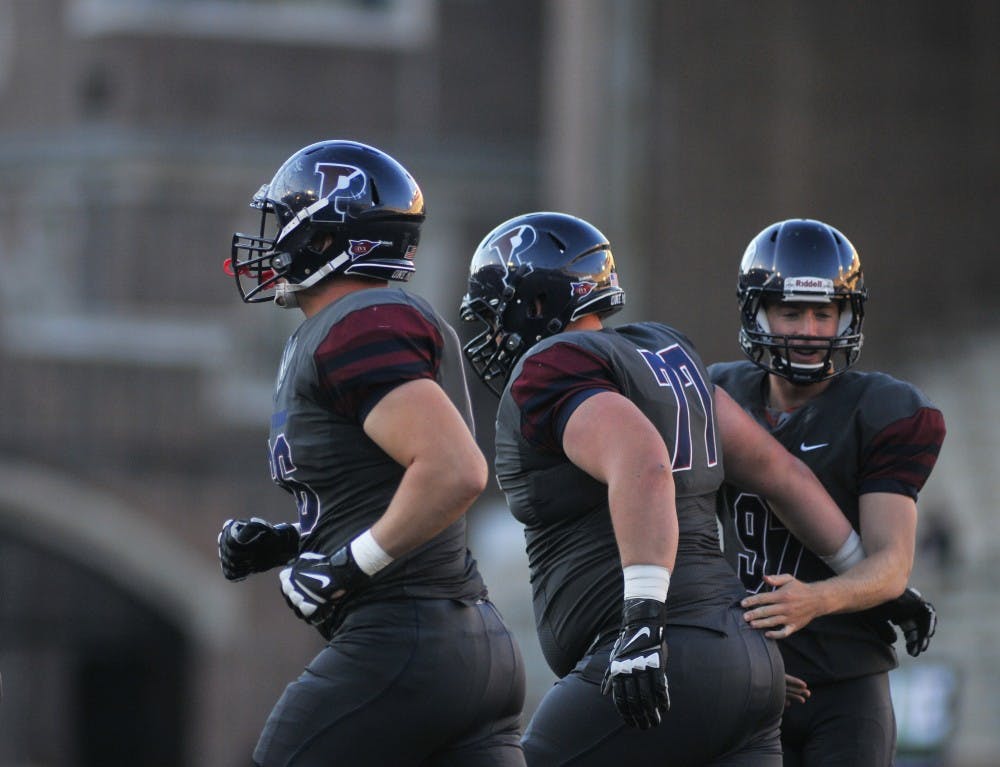
Senior offensive lineman and thrower Billy Bishop is among a select pool of athletes at Penn — those who undertake the rigors of two different sports.
Credit: Ananya Chandra , , ,Training to be a Division I athlete is tough enough to begin with. But training for two sports? Almost unheard of.
When children first learn to kick a ball, throw a pass, or swing a bat, they become enamored by the fun, self-challenging nature that is sports. However, even as soon as grade school, numbers begin to drop off significantly in youth sports participation. By the time high school rolls around, most athletes that remain outline a clear path for themselves — namely, whether or not they plan to play in college.
“I think I always wanted to keep swimming and running beyond high school,” freshman Meredith Newman said. “But it was around sophomore year of high school that I realized I was good enough.”
While only a small percentage of high school athletes prove talented enough for a Division I sport, an even smaller percentage of them prove talented enough for two.
The road is not as smooth as the description may make it sound. When one envisions a two-sport athlete, images of superhuman athleticism coupled with instant collegiate stardom may come to mind. But some two-sport competitors start like most other college athletes — being recruited for one sport.
“I was recruited to Penn for shot put,” senior Billy Bishop said. “But the offensive line coach for the football team kept asking me to come out to practice, and eventually I said yes. I talked to my parents and decided to go for it.”
Bishop has been a member of both the football and track & field teams since his sophomore year at Penn. In that time, he has faced the challenges of honing his skills in two sports while also maintaining academic rigor.
“It’s definitely been difficult, but not impossible,” Bishop said. “There were some nights where I got home from track practice and football lifts with tired legs and just wanted to rest. It teaches you how important it is to not procrastinate stuff.”
Newman, who in the fall was a member of both the swimming and track teams but recently decided to drop track, recounts a similar struggle.
“The main reason I felt like I had to stop running was because of my nursing course load,” Newman said. “It was difficult to manage my schedule with two different sports and a pretty rigid curriculum.”
Newman also discussed an issue that is prevalent among two-sport athletes — the idea that because their time is split between two sports, they cannot fully achieve their potential in either.
“My coaches were very accommodating even though I could only do half the practice time for each sport,” Newman said. “However, my coaches did express concern to me that I wasn’t dedicating enough time to either which would in turn make me mediocre.”
The flipside of that argument is that some sports can actually enhance one another, a philosophy that Bishop subscribes to wholeheartedly.
“Most sports are either strength based or speed based, and I happened to play two strength based sports,” Bishop said. “So I think the skills go hand-in-hand. If you look around the country it is very common to see offensive lineman playing other strength dependent sports.”
Whether it be an individual sport like shot put or a team sport like football, the bottom line for many of these athletes is that it is near-impossible to let something so important to their lives go by the wayside in college. For the athletes that are forced to give up one of the sports, the transition can be difficult.
“It’s been pretty weird thinking about how I won’t be running track competitively this year,” Newman said. “It’s just always something that’s been there, but now it’s not.”
For others like Bishop who continue playing both through college, the positive memories often outweigh the negative ones.
“It was tough at times, but whenever I think back, I just remember all the good times doing what I love with my friends,” Bishop said.
“If I were to do college over, I would do it again in a heartbeat.”
The Daily Pennsylvanian is an independent, student-run newspaper. Please consider making a donation to support the coverage that shapes the University. Your generosity ensures a future of strong journalism at Penn.
Donate







